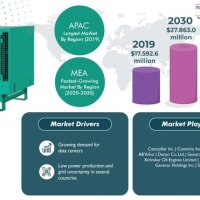
Increasing disposable income, stringent government policies, expanding cement manufacturing and mining industries, and rising environmental standards on water and air pollution are the key factors driving the growth of the liquid and air filter bags market. In 2017, the market generated a revenue of ,220.2 million, and it is predicted to attain a size of ,144.9 million by 2023, advancing at a CAGR of 6.5% during the forecast period (2018–2023), according to P&S Intelligence. Liquid and air filter bags are used in the filtration and removal of solids from liquids and gases.
On the basis of type, the liquid and air filter bags market is bifurcated into air and liquid. Of these, in 2017, the liquid filter bag type contributed more than 70.0% revenue to the market. Liquid filter bags are used in the filtration or removal of solids from liquids in areas such as adhesives, resins chemical, oils, bitumen, petroleum, food, paper, and water treatment. Hence, due to the wide range of applications, this type is expected to maintain its lead during the forecast period.
Browse report with detailed toc at: https://www.psmarketresearch.com/market-analysis/liquid-and-air-filter-bags-market/report-sample
Based on bag size, the liquid and air filter bags market is classified into 7OD*32’’, 7OD*17’’, 4OD*14’’, and 4OD*8’’. In 2017, out of these, the 7OD*32’’ classification held the largest share of 30.0% in terms of sales volume and is predicted to dominate the market during the 2018–2023 period. This is ascribed to the amazing chemical compatibility, superior product quality, and cost-efficiency of such long filter bags over other bags.
On the basis of end user, the liquid and air filter bags market is categorized into mining, steel and power, water treatment, chemicals and pharmaceuticals, cement, and others. Among these, in 2017, the chemicals and pharmaceuticals category contributed more than 31.0% revenue to the market. In this sector, liquid and air filter bags are widely adopted for removing dust and other unwanted foreign substances from the equipment machinery. This is why this end user is predicted to hold the largest share in the market during the forecast period.
Further, the demand for air and liquid filter bags from the mining industry and cement manufacturing facilities is growing. With the rise in infrastructure activities across the globe, there has been an increase in the setting up of mining and cement manufacturing industries. These industries use filter bags as a medium for removing the dust particles from the components, which are ultimately expelled into the air via chimneys during manufacturing process.
The government of various countries have started formulating regulations, such as the NESHAP (National Emission Standards for Hazardous Air Pollutants) in the U.S., for controlling harmful pollutants. Under this, manufacturing plants are required to attach filter bags on the equipment. If, in case the facility fails to follow the policies, it might be closed down. Thus, the rising adoption of the filtration process in the cement manufacturing and mining sector is boosting the liquid and air filter bags market growth.
Besides, the increasing usage of these bags in the pharmaceutical domain during processes such as filtration of gelatins, purification of carbon, and recovery of active ingredients, is expected to create immense opportunities for the players operating in the liquid and air filter bags during the forecast period. Another industry where these bags are used in huge amounts is automotive, with manufacturers attaching these to the engines of cars to protect them from harmful particles.
Hence, the expanding cement manufacturing and mining industries and rising adoption of these bags in pharmaceutical and automotive domains are strengthening the the market.
On the basis of type, the liquid and air filter bags market is bifurcated into air and liquid. Of these, in 2017, the liquid filter bag type contributed more than 70.0% revenue to the market. Liquid filter bags are used in the filtration or removal of solids from liquids in areas such as adhesives, resins chemical, oils, bitumen, petroleum, food, paper, and water treatment. Hence, due to the wide range of applications, this type is expected to maintain its lead during the forecast period.
Browse report with detailed toc at: https://www.psmarketresearch.com/market-analysis/liquid-and-air-filter-bags-market/report-sample
Based on bag size, the liquid and air filter bags market is classified into 7OD*32’’, 7OD*17’’, 4OD*14’’, and 4OD*8’’. In 2017, out of these, the 7OD*32’’ classification held the largest share of 30.0% in terms of sales volume and is predicted to dominate the market during the 2018–2023 period. This is ascribed to the amazing chemical compatibility, superior product quality, and cost-efficiency of such long filter bags over other bags.
On the basis of end user, the liquid and air filter bags market is categorized into mining, steel and power, water treatment, chemicals and pharmaceuticals, cement, and others. Among these, in 2017, the chemicals and pharmaceuticals category contributed more than 31.0% revenue to the market. In this sector, liquid and air filter bags are widely adopted for removing dust and other unwanted foreign substances from the equipment machinery. This is why this end user is predicted to hold the largest share in the market during the forecast period.
Further, the demand for air and liquid filter bags from the mining industry and cement manufacturing facilities is growing. With the rise in infrastructure activities across the globe, there has been an increase in the setting up of mining and cement manufacturing industries. These industries use filter bags as a medium for removing the dust particles from the components, which are ultimately expelled into the air via chimneys during manufacturing process.
The government of various countries have started formulating regulations, such as the NESHAP (National Emission Standards for Hazardous Air Pollutants) in the U.S., for controlling harmful pollutants. Under this, manufacturing plants are required to attach filter bags on the equipment. If, in case the facility fails to follow the policies, it might be closed down. Thus, the rising adoption of the filtration process in the cement manufacturing and mining sector is boosting the liquid and air filter bags market growth.
Besides, the increasing usage of these bags in the pharmaceutical domain during processes such as filtration of gelatins, purification of carbon, and recovery of active ingredients, is expected to create immense opportunities for the players operating in the liquid and air filter bags during the forecast period. Another industry where these bags are used in huge amounts is automotive, with manufacturers attaching these to the engines of cars to protect them from harmful particles.
Hence, the expanding cement manufacturing and mining industries and rising adoption of these bags in pharmaceutical and automotive domains are strengthening the the market.




















※コメント投稿者のブログIDはブログ作成者のみに通知されます